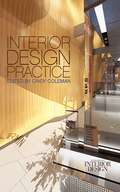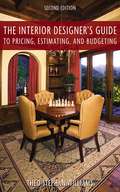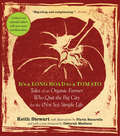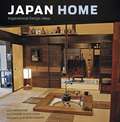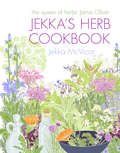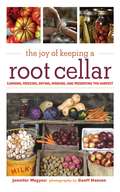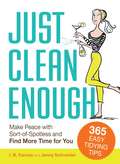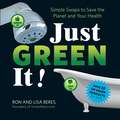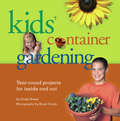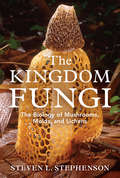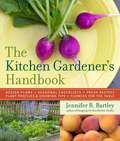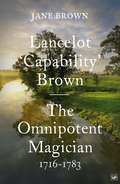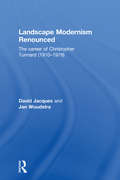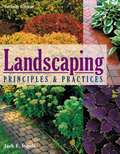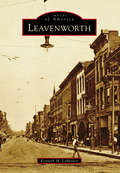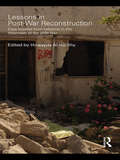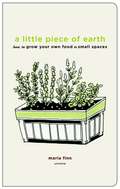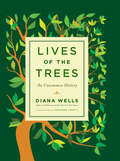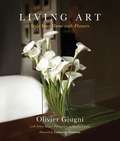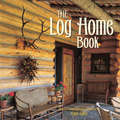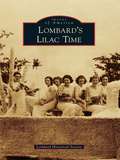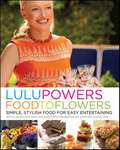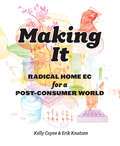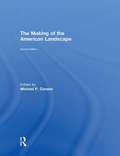- Table View
- List View
Interior Design Practice (Interior Design Ser.)
by Cindy ColemanInterior Design magazine has assembled some of the most notable voices in the interior design world today under editor-in-chief Cindy Coleman to define contemporary interior design and its practice. Interior Design Practice provides aspiring and practicing professionals a perspective that is as broad as it is deep, encompassing design theory and education, global professional practice, and the experiences of design firms large and small. An overview is provided of the development and growth of the profession, along with an in-depth assessment of the legal and regulatory environment. An extensive section is offered on the work process, ranging from pre-design, programming, and design development to contract administration. Finally, a section on management provides a thorough exploration of issues in marketing, financial management, project management, and managing client relationships. Both comprehensive and timely,Interior Design Practice describes the changes currently occurring in the design profession and industry and suggests new, unique ways of thinking and working that will serve as a catalyst for designers who seek excellence in their profession. List of Contributors, their company, and their location: - Edward Friedrichs, (former President, Gensler) San Francisco - Derrel Parker, Parker Scaggiari,Las Vegas - Cindy Coleman, Chicago - Beth Harmon Vaughan, Gensler, Phoenix - Barry LePatner, LePatner & Associates, LLP, New York - Eva Maddox, Perkins + Will, Chicago - Sharon Turner, Swanke Hayden Connell Architects, London - Pamela Anderson Brule, Pamela Anderson Brule Architects, San Jose - Orlando Diaz-Azcuy, San Francisco - Stuart Cohen, Cohen/Hacker Architects, Chicago - David Boeman, Powell + Kleinshmidt, Chicago - Greg Switzer, Robert Sutter, Switzer Architects, New York - Lisabeth Quebe, (Former VP, Perkins + Will) Soldiers Grove, WI - Gary Wheeler, Wheeler Kanik, Richmond, UK - Kathy Rogers, Jacobs Facilities, Arlington, VA
The Interior Designer's Guide to Pricing, Estimating, and Budgeting
by Theo Stephen WilliamsThis second edition is updated throughout and includes additional material on time management and numerous interviews with leading designers. Empowered by the step-by-step guidance in this book, interior designers will be able to establish prices and budgets that make their clients happy and their businesses profitable. Written by a designer and veteran expert on pricing, estimating, and budgeting systems, the book provides practical guidelines on how to value the cost of designing commercial or residential interiors, from the designer's creative input to the pricing of decorating products and procedures.The book shows how to determine a profitable and fair hourly rate, balance the client's budget with his or her wishes and needs, negotiate prices with suppliers and contractors, write realistic estimates and clear proposals, manage budgets for projects of all sizes and types, and position the firm's brand in relation to its practices. Interviews with experienced interior designers, case studies, and sidebars highlight professional pitfalls and how to master them, from daily crisis management and self-organization to finding the perfect office manager.
It's a Long Road to a Tomato: Tales of an Organic Farmer Who Quit the Big City for the (Not So) Simple Life
by Deborah Madison Keith Stewart Flavia BacarellaA new edition of longtime farmer Keith Stewart’s deeply personal and highly acclaimed book on the hows and whys of running a small organic farm in 21st century America—updated with five new essays, a foreword by Deborah Madison, and gorgeous new woodcuts by Flavia BacarellaKeith Stewart, already in his early forties and discontent with New York’s corporate grind, moved upstate and started a one-man organic farm in 1986. Today, having surmounted the seemingly endless challenges to succeeding as an organic farmer, Keith employs seven to eight seasonal interns and provides 100 varieties of fresh produce to the shoppers and chefs who flock twice weekly, May to December, to his stand at Union Square Greenmarket in Manhattan—the only place where his produce is sold. It’s a Long Road to a Tomato opens a window into the world of Keith’s Farm, with essays on Keith’s development as a farmer, the nuts and bolts of organic farming for an urban market, farm animals domestic and wild, and the political, social, and environmental issues relevant to agriculture today—and their impact on all of us.
Japan Home: Inspirational Design Ideas
by Lisa Parramore Noboru Murata Chadine Flood GongWhether you're remodeling your house, redesigning your apartment or just looking for a book of design ideas, Japan Home is a beautiful and indispensable resource full of practical information, shopping resources and inspiration.<P><P>Japanese interior design has long been renowned for its spare beauty, utility and grace. Today, more and more people outside Japan are incorporating Japanese features in their homes and gardens as they come to appreciate the way in which materials, colors, patterns and shapes are interwoven in a uniquely light and evocative way.Japan Home, lavishly illustrated with full-color photos and packed with practical information, is the perfect source for anyone eager to find ways to decorate or enhance their home with that special Japanese flair. The authors explore ways to create typical Japanese spaces both inside and outside the home that are tranquil yet dramatic, understated yet elegant. All designs are enriched with the distinct Japanese aesthetic.
Jekka's Herb Cookbook: Foreword by Jamie Oliver
by Jekka McVicarJekka McVicar's passion for herbs has evolved over 40 years. In this, her first cookery book, 'queen of herbs' Jekka offers over 250 original recipes using simple garden herbs, along with tips for growing and maintaining them.Herbs have long been a part of British culinary history, yet few people utilise them to their full potential. Incredibly versatile, not only do herbs impart flavour, aroma and texture to dishes, they are extremely beneficial to our health. Much more than a cookbook, Jekka's Herb Kitchen features 50 herbs with a chapter and recipes devoted to each - Jekka's huge knowledge of each herb's history, cultivation and medicinal and culinary uses is unsurpassed. Her recipes are simple and economical - she shows how herbs can transform a cheap cut of meat, enliven a pasta sauce, and even add delight to desserts. She also offers suggestions for how best to combine herbs and what parts to use, gives ideas for using up a glut of a specific herb, and advises on how to preserve your herbs for the winter months. Moreover, this volume is a family affair - many of Jekka's recipes are inspired by her grandmother and mother, and the stunning illustrations are by Jekka's daughter, Hannah McVicar. With colour photographs throughout, this is a unique and beautiful volume from the UK's foremost authority on herbs.
The Joy of Keeping a Root Cellar: Canning, Freezing, Drying, Smoking and Preserving the Harvest
by Jennifer Megyesi Geoff HansenThe winning team behind The Joy of Keeping Chickens returns, this time with a complete guide to building and maintaining a root cellar-even if it's just a dark and cool closet. This cheap, easy, energy-saving way will keep the harvest fresh all year long. Here, readers will learn: Which fruits and vegetables store best How to build a root cellar in the country, suburbs, or city How to deal with specific environmental challenges Storage techniques ranging from canning to pickling and smoking to drying Recipes for everything from tomato sauce to venison jerky Root cellaring isn't just for off-the-grid types or farmers with large gardens. Storing food makes good sense, both financially and environmentally. And root cellars can easily fit anywhere. In this intelligent, convincing book, authors Megyesi and Hansen show how to make them part of every reader's life.
Just Clean Enough: Home Organization in an Imperfect World
by I. B. Caruso Jenny SchroedelA clean house means peace of mind. But who has the time to keep on top of it? Fortunately, this book breaks down home organization and gives busy families a solution. Unlike other decluttering books that press for perfection, this flexible guide features tips for each room in the house and helps you tackle your clutter in any way that works for you. With helpful icons that highlight quick tasks more suitable for weeknights as well as time-consuming jobs best left for the weekend, you will clean up and still have time for fun! After all, why spend all day cleaning when it's easy to do small things, like: dump out the junk drawer, toss unnecessary papers, corral kids' toys, clean out the medicine cabinet. Before long, you will be able to clean up your act--one closet, one room, one day at a time!
Just Green It!
by Ron Beres Lisa BeresGoing Green has never been so easy!The array of so-called "green" products on the market is dizzying and often misleading. Consumers need one reference book that clearly lays out what is the better choice--between brands, benefits, and costs. Just Green It! compares brand-name products, making it easy for consumers to make environmentally friendly choices on everything from light bulbs to mattresses to baby food. It tells you which products are the best for the planet and also healthy for you, your kids, your home, and your budget. For the average consumer, this means clarity of green definitions and product comparisons that are no longer a luxury, but a necessity.Authors Ron and Lisa Beres debunk the "greenwashing" that is so prevalent in modern marketing and teach readers how to know the difference between such confusing terms as "natural," "organic," "chemical free," and "nontoxic."Full of surprising facts and lots of ways to save money and help the environment, this is an essential book for the modern age. Did you know that ...The Great Wall of China and the Staten Island Landfill--Fresh Kills--are the only two manmade structures on Earth that are large enough to be seen from outer space.It is a higher carbon footprint to drink imported vodka?The phosphoric acid in soda leaches calcium from our bones and can lead to osteoporosis?The Green Movement is concerned about the effects of our collective carbon footprint on the planet. A "green home" is one that does not endanger the planet's health. The Beres, on the other hand, are concerned with how our footprint is endangering the health and well being of each individual.A guidebook for navigating the oversaturated Green marketplace, Just Green It! is a must have for today's tough economy. Just GREEN It! was chosen in May 2011 as an honorable mention by San Francisco's 2011 Green Book Festival
Kids' Container Gardening: Year-Round Projects for Inside and Out
by Bruce Curtis Cindy KrezelEnthusiastic young gardeners have the opportunity to develop a green thumb and experience the joys of gardening in this how-to guide for kids. Eighteen time-tested, proven projects gleaned from the author's experience as director of the Good Earth Kids' Club teach children how to create a year-round assortment of container gardens that are simple to create, fun to work on, and in many instances, make great gifts. Organized by season, the chapters run the gamut from "Great Big Garden Bowls for Mom" and "Father's Day Fountains" to sand art terrariums and special occasion holiday containers. In addition to providing the basics on plants and gardening, this helpful guide also includes a glossary of terms, a listing of plants and resources used in the book, and numerous photographs to show kids that they're proceeding on the right path as they create their individual containers.
The Kingdom Fungi: The Biology of Mushrooms, Molds, and Lichens
by Steven L. StephensonThe ubiquitous fungi are little known and vastly underappreciated. Yet, without them we wouldn’t have bread, alcohol, cheese, tofu, or the unique flavors of mushrooms, morels, and truffles. We can’t survive without fungi. The Kingdom Fungi provides a comprehensive look at the biology, structure, and morphological diversity of these necessary organisms. It sheds light on their ecologically important roles in nature, their fascinating relationships with people, plants, and animals, and their practical applications in the manufacture of food, beverages, and pharmaceuticals. The book includes information about “true” fungi, fungus-like creatures (slime molds and water molds), and a group of “composite” organisms (lichens) that are more than just fungi. Particular attention is given to examples of fungi that might be found in the home and encountered in nature. The Kingdom Fungi is a useful introductory text for naturalists, mycologists, and anyone who wants to become more familiar with, and more appreciative of, the fascinating world of fungi.
The Kitchen Gardener's Handbook
by Jennifer R. Bartley“A mouthwatering picture book.” —Toronto Tasting Notes No longer content with separating the plants they grow to eat and the plants they grow for beauty, gardeners are discovering the pleasures of incorporating both edibles and ornamentals into their home landscapes. The Kitchen Gardener's Handbook makes it easy. Whether she's sharing tips on planting radishes in spring, harvesting tomatoes in summer, or pruning perennials in winter, Bartley's friendly advice gives gardeners the tools they need to build and maintain a kitchen garden. Readers will learn how to plant, grow, and harvest the best vegetables, fruits, greens, and herbs for every season. They'll also find seasonal recipes that celebrate the best of the harvest, monthly garden chores, eight sample garden designs, and information on using cut flowers for decoration. The Kitchen Gardener's Handbook is a guide for gardeners who want it all—the freshness of fruits and vegetables and the beauty and simplicity of hand-picked bouquets.
Lancelot 'Capability' Brown, 1716-1783: The Omnipotent Magician
by Jane BrownLancelot Brown changed the face of eighteenth-century England, designing country estates and mansions, moving hills and making flowing lakes and serpentine rivers, a magical world of green. This English landscape style spread across Europe and the world. At home, it proved so pleasing that Brown's influence spread into the lowland landscape at large, and into landscape painting. He stands behind our vision, and fantasy, of rural England. In this vivid, lively biography, based on detailed research, Jane Brown paints an unforgettable picture of the man, his work, his happy domestic life, and his crowded world. She follows the life of the jovial yet elusive Mr Brown, from his childhood and apprenticeship in rural Northumberland, through his formative years at Stowe, the most famous garden of the day. His innovative ideas, and his affable and generous nature, led to a meteoric rise to a Royal Appointment in 1764 and his clients and friends ranged from statesmen like the elder Pitt to artists and actors like David Garrick. Riding constantly across England, Brown never ceased working until he collapsed and died in February 1783 after visiting one of his oldest clients. He was a practical man but also a visionary, always willing to try something new. As this beautifully illustrated biography shows, Brown filled England with enchantment - follies, cascades, lakes, bridges, ornaments, monuments, meadows and woods - creating views that still delight us today.
Landscape Modernism Renounced: The Career of Christopher Tunnard (1910-1979)
by Jan Woudstra David JacquesBefore the Second World War landscape architect Christopher Tunnard was the first author on Modernism in Landscape in the English language, but later became alarmed by the destructive forces of Post-war reconstruction. Between the 1950s and the 1970s he was in the forefront of the movement to save the city, becoming an acclaimed author sympathetic to preservation. Ironically it was the Modernist ethos that he had so fervently advocated before the war that was the justification for the dismemberment of great cities by officials, engineers and planners. This was not the first time that Tunnard had to re-evaluate his principles, as he had done so in the 1930s in rejecting Arts-and-Crafts in favour of Modernism. This book tracks his changing ideology, by reference to his writings, his colleagues and his work. Christopher Tunnard is one of the most influential figures in Landscape Architecture and his journey is one that still resonates in the discipline today. His leading role in first embracing the tenets of Modernism and then moving away from to embrace a more conservationist approach can be seen in the success and impact on the profession of those with whom he worked and taught.
Landscaping: Principles and Practices (7th edition)
by Jack IngelsLandscaping: Principles & Practices, 7th Edition provides the basic knowledge and industry information needed to be successful in the field of landscape design and architecture. Focusing on three areas of professional practice; design, contracting and management, traditional topics such as design, plant installation, and pricing are covered, as well as topics not found in most other books, such as interior landscaping, xeriscaping, water gardens, and safety.
Le Japon Artistique: Japanese Floral Pattern Design in the Art Nouveau Era
by Museum of Fine Arts, Boston Rachel SaundersCelebrating an era of dynamic and creative cross-pollination between Japanese design and European Art Nouveau at theturn of the last century, Le Japon Artistique features stunning floral imagery drawn from a variety of rare books held in the collection of the Museum of Fine Arts, Boston. Seldom seen outside the museum context, these lush botanical motifs are as visually enchanting as they are significant in the arc of Japanese art history. This treat for art and design lovers is the perfect pick for springtime gift giving.
Leavenworth
by Kenneth M. LamasterOn May 30, 1854, Pres. Franklin Pierce signed the hotly contested Kansas-Nebraska Act. Before the ink was dry, squatters settled on the 322-acre plot of land bounded by the Fort Leavenworth Military Reservation (to the north) and Three Mile Creek (to the south). From Bleeding Kansas to western expansion, many historical figures have called Leavenworth home, including Fred Harvey, Buffalo Bill Cody, and Wild Bill Hickok, to name but a few. The landscape is decorated with buildings and homes featuring a beauty and grandeur that have stood the test of time. Originally known as the �Queen City of the West,� this metropolis would become one of the largest manufacturing cities in America, providing goods and services to markets all over the world. Historical churches, the Leavenworth VA Medical Center, the Sisters of Charity of Leavenworth, and Leavenworth National Cemetery all contribute to the town�s pioneering spirit that is second to none.
Lessons in Post-War Reconstruction: Case Studies from Lebanon in the Aftermath of the 2006 War (Planning, History and Environment Series)
by Howayda Al-HarithyAfter the ceasefire, a group of architects and planners from the American University of Beirut formed the Reconstruction Unit to help in the recovery process and in rebuilding the lives of those affected by the 2006 war in Lebanon . Here, a series of case studies documenting the work of the Unit discusses the lessons to be learned from the experiences of Lebanon after the July War, and suggests how those lessons might be applied elsewhere. The cases are diverse in terms of scale, type of intervention, methods, and approaches to the situation on the ground. Critical issues such as community participation, heritage protection, damage assessment and compensation policies, the role of the state, and capacity building are explored and the success and failures assessed.
A Little Piece of Earth: How to Grow Your Own Food in Small Spaces
by Maria FinnA hip, eco-friendly guide with fun and easy projects for all levels. Eating locally has so many benefits--for the planet, for your health, and for your taste buds--and you can't get much more local than your very own backyard. But is planting a garden too big a commitment? Then this book is for you. A Little Piece of Earth is all about starting small, with more than fifty self-contained, doable projects. Whether you have a yard, a terrace, a rooftop, or just a windowsill, there are plenty of ideas and inspirations to choose from. Harvest your own precious vanilla pods from a pot indoors. Grow savory shiitakes on a small log in your kitchen. Build a miniature vineyard trellis on your deck or build a raised bed on your patio. Recipes for using your homegrown bounty are sprinkled throughout. Charming illustrations guide you through step-by-step, and there's a complete resources section. This is about making dirt work for you, taking some control over your food supply, and, most important, enriching your life with the quiet, simple pleasures of produce raised organically with your own hands.
Lives of the Trees: An Uncommon History
by Diana WellsDiana Wells, author of 100 Flowers and How They Got Their Names now turns her attention to something bigger—our deep-rooted relationship with trees. As she investigates the names and meanings of trees, telling their legends and lore, she reminds us of just how innately bound we are to these protectors of our planet. <P><P>Since the human race began, we have depended on them for food, shade, shelter and fuel, not to mention furniture, musical instruments, medicine utensils and more. Wells has a remarkable ability to dig up the curious and the captivating: At one time, a worm found in a hazelnut prognosticated ill fortune. Rowan trees were planted in churchyards to prevent the dead from rising from their graves. Greek arrows were soaked in deadly yew, and Shakespeare’s witches in Macbeth used “Gall of goat and slips of Yew” to make their lethal brew. One bristlecone pine, at about 4,700 years old, is thought to be the oldest living plant on earth. <P>All this and more can be found in the beautifully illustrated pages (themselves born of birch bark!) of 100 Trees.
Living Art
by Olivier GiugniOlivier Giugni, the renowned floral artist, presents stunning portraits of his sumptuous creations in a variety of private homes, along with detailed descriptions of their design and placement--and recipes for a dozen of his signature arrangements.Life is color and color is life. This is the mantra of Olivier Giugni, founder and owner of L'Olivier, the sleek floral design atelier in Manhattan. Far from Brignoles, the Provençal village where he grew up, Olivier reimagines the warmth, whimsy, style, and bursts of color from his native France in a singularly contemporary fashion, and in doing so, he has become one of the New York area's most beloved and acclaimed floral designers.Created from a breathtaking range of organic and sustainable material, Olivier's work becomes living sculpture, drawing from and reflecting back the signature elements of its surrounding environment. True to this vision, his gorgeous, lush arrangements of dramatic flowers and plants inspire and transform every space they occupy.In Living Art, Olivier walks readers through the homes of eighteen of his clients as well as his own, pointing out how their art, furnishings, and design preferences engage in a call-and-response with his unique arrangements. Along the way, Olivier's creative thought process is revealed, showing how composition, color, texture, and fragrance can have a subtle yet decisive impact on the energy of a room, enhancing and elevating mood and moment.Living Art's spectacular images illuminate this master florist's aesthetic approach in an accessible way. A gift for experienced arrangers or novices just learning to work with flowers, the book includes recipes for twelve of Olivier's unique arrangements, offering novel ways to style flowers, plants, and foliage--from cascade to orchid garden to bouquet. The poetic, playful creativity featured in Living Art will move and spark the imagination of all those who are passionate about flowers.
The Log Home Book
by Ralph KylloeRoom-by-room inspiration for the affordable mountain retreat of your dreams, from the author of Rustic Elegance and Ralph Kylloe&’s Rustic Living. A foremost authority on rustic design and furnishings, Ralph Kylloe chose for this book his most inspiring images from twenty years of photographing mountain retreats across America. Richly layered images of living rooms, kitchens, dining rooms, bedrooms, bathrooms, and recreation rooms are a springboard for cabin planning and vacation dreaming.
Lombard's Lilac Time
by Lombard Historical SocietyLombard has been called the "Lilac Village" since the late 1920s when William R. Plum, affectionately known as the "Colonel," bestowed his world-renowned lilac collection to the village for use as its first public park. Colonel Plum's 2.5-acre estate was known as Lilacia and began in 1911 after a trip to the Lemoine Lilac Gardens in France. By the time Plum passed away in 1927, he had amassed over 200 varieties of lilacs and had the largest collection of French hybrids in the world. Jens Jensen, the famous landscape architect, designed a public space out of Plum's lilac collection with winding paths of native limestone, tulips by the thousands, and a lily pond in the park. The first community-wide Lilac Festival was held in May of 1930, unveiling Jensen's Lilacia and including a Lilac Queen and Court, a pageant, parade, and wide variety of events and festivities celebrating the village's new park.
Lulu Powers Food to Flowers: Simple, Stylish Food for Easy Entertaining
by Lulu Powers Laura Holmes HaddadFrom Lulu Powers, one of Los Angeles’s premier caterers and event planners, comes a lively, lushly photographed, full-color cookbook featuring 175 recipes and inspired party-planning tips. Lulu Powers Food to Flowers offers simple, stylish food for easy entertaining—invaluable steps to the perfect party or gathering, from a Coffee and Newspaper Party to a Retro Game Night to a Big City Cocktail Party.
Making It: Radical Home Ec for a Post-Consumer World
by Kelly Coyne Erik KnutzenSpending money is the last thing anyone wants to do right now. We are in the midst of a massive cultural shift away from consumerism and toward a vibrant and very active countermovement that has been thriving on the outskirts for quite some time—do-it-yourselfers who make frugal, homemade living hip are challenging the notion that true wealth has anything to do with money. In Making It, Coyne and Knutzen, who are at the forefront of this movement, provide readers with all the tools they need for this radical shift in home economics.The projects range from simple to ambitious and include activities done in the home, in the garden, and out in the streets. With step-by-step instructions for a wide range of projects—from growing food in an apartment and building a ninety-nine-cent solar oven to creating safe, effective laundry soap for pennies a gallon and fishing in urban waterways—Making It will be the go-to source for post-consumer living activities that are fun, inexpensive, and eminently doable. Within hours of buying this book, readers will be able to start transitioning into a creative, sustainable mode of living that is not just a temporary fad but a cultural revolution.
The Making of the American Landscape
by Michael P. ConzenThe only compact yet comprehensive survey of environmental and cultural forces that have shaped the visual character and geographical diversity of the settled American landscape. The book examines the large-scale historical influences that have molded the varied human adaptation of the continent’s physical topography to its needs over more than 500 years. It presents a synoptic view of myriad historical processes working together or in conflict, and illustrates them through their survival in or disappearance from the everyday landscapes of today.
